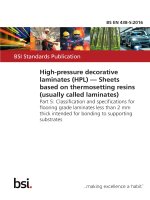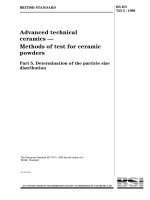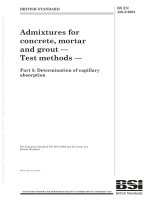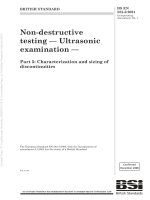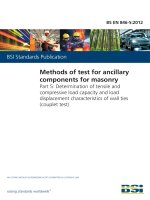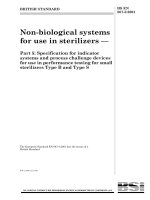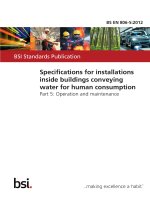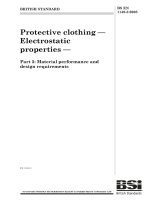Bsi bs en 60794 5 10 2014
Bạn đang xem bản rút gọn của tài liệu. Xem và tải ngay bản đầy đủ của tài liệu tại đây (1.37 MB, 38 trang )
BS EN 60794-5-10:2014
BSI Standards Publication
Optical fibre cables
Part 5-10: Family specification —
Outdoor microduct optical fibre cables,
microducts and protected microducts for
installation by blowing
BRITISH STANDARD
BS EN 60794-5-10:2014
National foreword
This British Standard is the UK implementation of EN 60794-5-10:2014. It is
identical to IEC 60794-5-10:2014.
The UK participation in its preparation was entrusted by Technical Committee GEL/86, Fibre optics, to Subcommittee GEL/86/1, Optical fibres and
cables.
A list of organizations represented on this committee can be obtained on
request to its secretary.
This publication does not purport to include all the necessary provisions of
a contract. Users are responsible for its correct application.
© The British Standards Institution 2014.
Published by BSI Standards Limited 2014
ISBN 978 0 580 62099 7
ICS 33.180.01; 33.180.10
Compliance with a British Standard cannot confer immunity from
legal obligations.
This British Standard was published under the authority of the
Standards Policy and Strategy Committee on 31 May 2014.
Amendments/corrigenda issued since publication
Date
Text affected
BS EN 60794-5-10:2014
EN 60794-5-10
EUROPEAN STANDARD
NORME EUROPÉENNE
EUROPÄISCHE NORM
April 2014
ICS 33.180.01; 33.180.10
English version
Optical fibre cables Part 5–10: Family specification Outdoor microduct optical fibre cables, microducts and protected
microducts for installation by blowing
(IEC 60794-5-10:2014)
Câbles à fibres optiques Partie 5–10: Spécification de famille Câbles extérieurs à fibres optiques en
micro-conduit, micro-conduits et microconduits protégés pour installation par
soufflage
(CEI 60794-5-10:2014)
Lichtwellenleiterkabel Teil 5-10: Familienspezifikation für
Mikrorohr-Lichtwellenleiterkabel,
Mikrorohre und geschützte Mikrorohre zur
Installation durch Einblasen für die
Anwendung im Freien
(IEC 60794-5-10:2014)
This European Standard was approved by CENELEC on 2014-03-12. CENELEC members are bound to comply
with the CEN/CENELEC Internal Regulations which stipulate the conditions for giving this European Standard
the status of a national standard without any alteration.
Up-to-date lists and bibliographical references concerning such national standards may be obtained on
application to the CEN-CENELEC Management Centre or to any CENELEC member.
This European Standard exists in three official versions (English, French, German). A version in any other
language made by translation under the responsibility of a CENELEC member into its own language and notified
to the CEN-CENELEC Management Centre has the same status as the official versions.
CENELEC members are the national electrotechnical committees of Austria, Belgium, Bulgaria, Croatia, Cyprus,
the Czech Republic, Denmark, Estonia, Finland, Former Yugoslav Republic of Macedonia, France, Germany,
Greece, Hungary, Iceland, Ireland, Italy, Latvia, Lithuania, Luxembourg, Malta, the Netherlands, Norway, Poland,
Portugal, Romania, Slovakia, Slovenia, Spain, Sweden, Switzerland, Turkey and the United Kingdom.
CENELEC
European Committee for Electrotechnical Standardization
Comité Européen de Normalisation Electrotechnique
Europäisches Komitee für Elektrotechnische Normung
CEN-CENELEC Management Centre: Avenue Marnix 17, B - 1000 Brussels
© 2014 CENELEC -
All rights of exploitation in any form and by any means reserved worldwide for CENELEC members.
Ref. No. EN 60794-5-10:2014 E
BS EN 60794-5-10:2014
EN 60794-5-10:2014
-2-
Foreword
The text of document 86A/1496/CDV, future edition 1 of IEC 60794-5-10, prepared by SC 86A "Fibres
and cables" of IEC/TC 86 "Fibre optics" was submitted to the IEC-CENELEC parallel vote and
approved by CENELEC as EN 60794-5-10:2014.
The following dates are fixed:
•
latest date by which the document has to be
implemented at national level by
publication of an identical national
standard or by endorsement
(dop)
2014-12-12
•
latest date by which the national
standards conflicting with the
document have to be withdrawn
(dow)
2017-03-12
Attention is drawn to the possibility that some of the elements of this document may be the subject of
patent rights. CENELEC [and/or CEN] shall not be held responsible for identifying any or all such
patent rights.
Endorsement notice
The text of the International Standard IEC 60794-5-10:2014 was approved by CENELEC as a
European Standard without any modification.
In the official version, for Bibliography, the following notes have to be added for the standards
indicated:
IEC 60794-1-21
NOTE
Harmonized as EN 60794-1-21.
IEC 60811-501
NOTE
Harmonized in EN 60811-501.
BS EN 60794-5-10:2014
EN 60794-5-10:2014
-3-
Annex ZA
(normative)
Normative references to international publications
with their corresponding European publications
The following documents, in whole or in part, are normatively referenced in this document and are
indispensable for its application. For dated references, only the edition cited applies. For undated
references, the latest edition of the referenced document (including any amendments) applies.
NOTE When an international publication has been modified by common modifications, indicated by (mod), the relevant EN/HD
applies.
Publication
Year
Title
EN/HD
Year
IEC 60304
-
Standard colours for insulation for lowfrequency cables and wires
HD 402 S2
-
IEC 60793-1-40
(mod)
-
Optical fibres Part 1-40: Measurement methods and test
procedures - Attenuation
EN 60793-1-40
-
IEC 60793-2-10
-
Optical fibres EN 60793-2-10
Part 2-10: Product specifications - Sectional
specification for category A1 multimode fibres
-
IEC 60793-2-50
-
Optical fibres Part 2-50: Product specifications - Sectional
specification for class B single-mode fibres
EN 60793-2-50
-
IEC 60794-1
-
Optical fibre cables Part 1: Generic specification
-
-
IEC 60794-1-1
-
Optical fibre cables Part 1-1: Generic specification - General
EN 60794-1-1
-
IEC 60794-1-2
-
Optical fibre cables Part 1-2: Generic specification - Cross
reference table for optical cable test
procedures
EN 60794-1-2
-
IEC 60794-1-22
2012
Optical fibre cables EN 60794-1-22
Part 1-22: Generic specification - Basic optical
cable test procedures - Environmental test
methods
2012
IEC 60794-1-23
-
Optical fibre cables EN 60794-1-23
Part 1-23: Generic specification - Basic optical
cable test procedures - Cable element test
methods
-
IEC 60794-1-24
-
Optical fibre cables EN 60794-1-24
Part 1-24: Generic specification - Basic optical
cable test procedures - Electrical test methods
-
IEC 60794-2
-
Optical fibre cables EN 60794-2
Part 2: Indoor cables - Sectional specification
-
IEC 60794-3
-
Optical fibre cables Part 3: Sectional specification - Outdoor
cables
IEC 60794-4
-
Optical fibre cables EN 60794-4
Part 4: Sectional specification - Aerial optical
cables along electrical power lines
-
IEC 60794-5
-
Optical fibre cables Part 5: Sectional specification - Microduct
cabling for installation by blowing
-
EN 60794-3
EN 60794-5
BS EN 60794-5-10:2014
EN 60794-5-10:2014
Publication
Year
-4Title
EN/HD
Year
IEC 60794-5-20
-
Optical fibre cables Part 5-20: Family specification for outdoor
microduct fibre units, microducts and
protected microducts for installation by
blowing
EN 60794-5-20
-
IEC 60811-202
-
Electric and optical fibre cables - Test
methods for non-metallic materials Part 202: General tests - Measurement of
thickness of non-metallic sheath
EN 60811-202
-
IEC 60811-203
-
Electric and optical fibre cables - Test
methods for non-metallic materials Part 203: General tests - Measurement of
overall dimensions
EN 60811-203
-
IEC 60811-601
-
Electric and optical fibre cables - Test
EN 60811-601
methods for non-metallic materials Part 601: Physical tests - Measurement of the
drop point of filling compounds
-
IEC 60811-602
-
Electric and optical fibre cables - Test
EN 60811-602
methods for non-metallic materials Part 602: Physical tests - Separation of oil in
filling compounds
-
IEC 60811-604
-
Electric and optical fibre cables - Test
methods for non-metallic materials Part 604: Physical tests - Measurement of
absence of corrosive components in filling
compounds
EN 60811-604
-
ISO/IEC 11801
-
Information technology - Generic cabling for
customer premises
EN ISO/IEC 11801 -
–2–
BS EN 60794-5-10:2014
60794-5-10 © IEC:2014
CONTENTS
1
Scope .............................................................................................................................. 7
2
Normative references ...................................................................................................... 7
3
Symbols .......................................................................................................................... 8
4
General requirements ...................................................................................................... 9
4.1
5
Construction ...................................................................................................... 9
4.1.1
General ............................................................................................ 9
4.1.2
Microduct optical fibre cables.......................................................... 10
4.1.3
Microduct ........................................................................................ 10
4.1.4
Protected microduct ........................................................................ 10
4.1.5
Microduct fittings ............................................................................ 10
4.1.6
Microduct hardware ........................................................................ 11
Optical fibres ................................................................................................... 11
4.2
4.3
Installation performance tests .......................................................................... 11
4.3.1
Installation conditions ..................................................................... 11
4.3.2
Tests applicable ............................................................................. 11
Mechanical and environmental tests ................................................................ 12
4.4
Microduct optical fibre cable .......................................................................................... 12
6
5.1
Tests applicable ............................................................................................... 12
5.2
Tensile performance ........................................................................................ 12
5.3
Crush ............................................................................................................... 13
5.4
Impact .............................................................................................................. 13
5.5
Repeated bending ............................................................................................ 13
5.6
Torsion ............................................................................................................ 13
5.7
Kink ................................................................................................................. 14
5.8
Bend ................................................................................................................ 14
5.9
Temperature cycling ........................................................................................ 14
5.10
Water penetration ............................................................................................ 15
5.11
Ageing ............................................................................................................. 15
5.12
Ribbon strippability .......................................................................................... 15
5.13
Fibre ribbon separability................................................................................... 15
Microduct....................................................................................................................... 15
7
6.1
Tests applicable ............................................................................................... 15
6.2
Tensile performance ........................................................................................ 16
6.3
Crush ............................................................................................................... 16
6.4
Impact .............................................................................................................. 16
6.5
Repeated bending ............................................................................................ 16
6.6
Torsion ............................................................................................................ 17
6.7
Kink ................................................................................................................. 17
6.8
Bend ................................................................................................................ 17
6.9
Microduct route verification test ....................................................................... 17
6.10
Microduct pressure withstand ........................................................................... 17
6.11
Ageing ............................................................................................................. 18
Protected microduct(s) .................................................................................................. 18
BS EN 60794-5-10:2014
60794-5-10 © IEC:2014
–3–
7.1
Tests applicable ............................................................................................... 18
7.2
Tensile performance ........................................................................................ 18
7.3
Crush ............................................................................................................... 19
7.4
Impact .............................................................................................................. 19
7.5
Repeated bending ............................................................................................ 19
7.6
Kink ................................................................................................................. 19
7.7
Bend ................................................................................................................ 20
7.8
Microduct route verification test ....................................................................... 20
7.9
Microduct pressure withstand ........................................................................... 20
7.10
Ageing ............................................................................................................. 20
Annex A (informative) Examples of microduct optical fibre cables and microducts ............... 21
Annex B (informative) Family specifications for microduct optical fibre cable,
microduct and protected microduct (blank detail specifications and minimum
requirements) ................................................................................................................ 23
B.1
Microduct optical fibre cable description ........................................................... 23
B.2
Microduct description ....................................................................................... 24
B.3
Protected microduct description ....................................................................... 25
Annex C (normative) Product constructions ......................................................................... 26
Annex D (normative) Transmission requirements ................................................................. 29
Attenuation of cabled fibre ............................................................................... 29
D.1
D.2
Fibre bandwidth requirements .......................................................................... 30
Annex E (normative) IEC 60794-1-21, Method Exx – Microduct inner clearance test ............ 31
Object .............................................................................................................. 31
E.1
E.2
General ............................................................................................................ 31
E.3
Sample ............................................................................................................ 31
E.4
Test equipment ................................................................................................ 31
E.5
Procedure ........................................................................................................ 31
E.6
Requirements .................................................................................................. 31
E.7
Details to be recorded ...................................................................................... 31
Bibliography .......................................................................................................................... 33
Figure A.1 – Microduct optical fibre cables (not to scale) ...................................................... 21
Figure A.2 – Protected microduct in pre-installed ducts (not to scale) ................................... 21
Figure A.3 – Protected microduct with tight integral outer duct (not to scale) ........................ 22
Table 1 – Tests applicable for installation performance ......................................................... 12
Table 2 – Tests applicable for mechanical and environmental performance of microduct
cable..................................................................................................................................... 12
Table 3 – Tests applicable for mechanical and environmental performance of a
microduct .............................................................................................................................. 15
Table 4 – Tests applicable for mechanical and environmental performance of a
protected microduct .............................................................................................................. 18
Table C.1 – Outdoor microduct optical fibre cable construction ............................................. 26
Table C.2 – Microduct construction ....................................................................................... 27
Table C.3 – Protected microduct construction ....................................................................... 28
Table D.1 – Multimode maximum cable attenuation coefficient (dB/km) ................................ 29
Table D.2 – Single-mode maximum cable attenuation coefficient (dB/km) – Premises
cabling applications .............................................................................................................. 29
–4–
BS EN 60794-5-10:2014
60794-5-10 © IEC:2014
Table D.3 – Single-mode maximum cable attenuation coefficient (dB/km) – All other
applications .......................................................................................................................... 29
Table D.4 – Minimum multimode fibre bandwidth (MHz × km) ............................................... 30
BS EN 60794-5-10:2014
60794-5-10 © IEC:2014
–7–
OPTICAL FIBRE CABLES –
Part 5-10: Family specification –
Outdoor microduct optical fibre cables, microducts and protected
microducts for installation by blowing
1
Scope
This part of IEC 60794 is a family specification that covers outdoor microduct optical fibre
cables for installation by blowing and the associated microducts, which together make up a
microduct optical fibre cable system. Although primarily designed for use with outdoor
microduct applications, the cable products specified herein may be used individually for short
lengths in other applications as agreed upon between supplier and customer. These may
include short runs inside a building or in other outdoor applications, such as a transition
between separate (unconnected) microduct systems, or from a microduct system to some
other protective structure such as a cable conduit or tray.
Systems built with components covered by this standard are subject to the requirements of
IEC 60794-5 where applicable.
Annex A shows examples of microduct optical fibre cables and microducts. Annex B describes
a blank detail specification for outdoor microduct optical fibre cables and the associated
microducts, and incorporates some minimum requirements. Detail product specifications may
be prepared on the basis of this family specification using Annex B as a guide. Annex C
provides normative requirements for microduct optical fibre cables.
The parameters specified in this standard may be affected by measurement uncertainty
arising either from measurement errors or calibration errors due to lack of suitable standards.
Acceptance criteria should be interpreted with respect to this consideration.
The number of fibres and microducts tested shall be representative of the microduct optical
fibre cable design and should be agreed between customer and supplier.
2
Normative references
The following documents, in whole or in part, are normatively referenced in this document and
are indispensable for its application. For dated references, only the edition cited applies. For
undated references, the latest edition of the referenced document (including any
amendments) applies.
IEC 60304, Standard colours for insulation for low-frequency cables and wires
IEC 60793-1-40, Optical fibres – Part 1-40: Measurement methods and test procedures –
Attenuation
IEC 60793-2-10, Optical fibres – Part 2-10: Product specifications – Sectional specification for
category A1 multimode fibres
IEC 60793-2-50, Optical fibres – Part 2-50: Products specification – Sectional specification for
class B single-mode fibres
IEC 60794 (all parts), Optical fibre cables
–8–
BS EN 60794-5-10:2014
60794-5-10 © IEC:2014
IEC 60794-1-1, Optical fibre cables – Part 1-1: Generic specification – General
IEC 60794-1-2, Optical fibre cables – Part 1-2: Generic specification – Basic optical cable test
procedures
IEC 60794-1-22:2012, Optical fibre cables – Part 1-22: Generic specification – Basic optical
cable test procedures – Environmental test methods
IEC 60794-1-23, Optical fibre cables – Part 1-23: Generic specification – Basic optical cable
test procedures – Cable elements test methods
IEC 60794-1-24, Optical fibre cables – Part 1-24: Generic specification – Basic optical cable
test procedures – Electrical test methods 1
IEC 60794-2, Optical fibre cables – Part 2: Indoor optical fibre cables – Sectional specification
IEC 60794-3, Optical fibre cables – Part 3: Sectional specification – Outdoor cables
IEC 60794-4, Optical fibre cables – Part 4: Sectional specification – Aerial optical cables
along electrical power lines
IEC 60794-5, Optical fibre cables – Part 5: Sectional specification – Microduct cabling for
installation by blowing
IEC 60794-5-20, Optical fibre cables – Part 5-20: Family specification – Outdoor microduct
fibre units, microducts and protected microducts for installation by blowing 1
IEC 60811-202, Electric and optical fibre cables – Test methods for non-metallic materials –
Part 202: General tests – Measurement of thickness of non-metallic sheath
IEC 60811-203, Electric and optical fibre cables – Test methods for non-metallic materials –
Part 203: General tests – Measurement of overall dimensions
IEC 60811-601, Electric and optical fibre cables – Test methods for non-metallic materials –
Part 601: Physical tests – Measurement of the drop-point of filling compounds
IEC 60811-602, Electric and optical fibre cables – Test methods for non-metallic materials –
Part 602: Physical tests – Separation of oil in filling compounds
IEC 60811-604, Electric and optical fibre cables – Test methods for non-metallic materials –
Part 604: Physical tests – Measurement of absence of corrosive components in filling
compounds
ISO/IEC 11801, Information technology − Generic cabling for customer premises
3
Symbols
For the purposes of this document, the following symbols apply.
∆D
Minimum wall thickness
∆D’
Minimum thickness of the outer sheath of the protected microduct
d
Nominal outer diameter of the microduct cable
___________
1
To be published.
BS EN 60794-5-10:2014
60794-5-10 © IEC:2014
–9–
DS
Detail specification
ID
Nominal inner diameter of the microduct
OD
Nominal outer diameter of the microduct
OD’
Nominal outer diameter of the protected microduct
T A1
Temperature cycling test low-temperature limit (usage and storage) according to
IEC 60794-1-22, Method F1
T A2
Temperature cycling test secondary low-temperature limit for extended storage
temperature range according to IEC 60794-1-22, Method F1
T B1
Temperature cycling test high-temperature limit (usage and storage) according to
IEC 60794-1-22, Method F1
T B2
Temperature cycling test secondary high-temperature limit for extended storage
temperature range according to IEC 60794-1-22, Method F1
t1
Temperature cycling dwell time
n×d
The product of a variable and the cable outer diameter used for determining
appropriate sizes for bends, mandrels, etc.
n × OD
The product of a variable and the outer diameter of the microduct used for
determining appropriate sizes for bends, mandrels, etc.
n × OD’
The product of a variable and the outer diameter of the protected microduct used
for determining appropriate sizes for bends, mandrels, etc.
W
Weight of 1 km of microduct, protected microduct or microduct optical fibre cable
4
General requirements
4.1
4.1.1
Construction
General
In addition to the construction requirements of IEC 60794-5, where applicable, the following
considerations apply to outdoor microduct optical fibre cables and their corresponding
microducts and protected microducts.
The products covered in this specification shall be designed and manufactured for expected
operating lifetimes of at least 20 years. The microduct optical fibre cables are designed to be
installed in microducts or protected microducts and in appropriate housings. The microducts
and protected microducts that are compatible for use with microduct optical fibre cables are
defined in this standard. Microduct optical fibre cables are optimized for installation and
operational life in these microducts.
It shall be possible to install or remove the microduct optical fibre cable from microduct or
protected microduct by blowing during the operational lifetime, except under the following
conditions:
a) products are compromised by multiple installation or removal operations;
b) microducts fouled with sediment, debris or other foreign matter due to inadequate
maintenance;
c) microducts subsequently damaged by extrinsic factors such as diggings, earth upheavals,
etc.
In such cases, the affected section of microduct shall be cleared or repaired, or products
replaced prior to any microduct cable installations.
The microduct fitness should be verified with dimensional clearance and static pressure
testing of the microduct route.
– 10 –
BS EN 60794-5-10:2014
60794-5-10 © IEC:2014
The materials in the microduct optical fibre cable, microduct or protected microduct shall not
present a health hazard within its intended use.
4.1.2
Microduct optical fibre cables
Microduct optical fibre cables are suitable for installation by blowing into a microduct.
Although not specifically addressed by cable products specifications such as IEC 60794-2,
IEC 60794-3 or IEC 60794-4, cable products specifically designed for installation by blowing
into microducts may also comply with other such industry standards and specifications.
However, they are often not as mechanically robust as traditional outdoor optical fibre cables
and, therefore, require the use of suitable installation and handling practices to prevent
damage. Ad hoc installation practices could degrade optical performance or reduce the
products’ operating lifetimes.
4.1.3
Microduct
A microduct suitable for installation of microduct cables is a small, flexible, lightweight tube
with an outer diameter typically less than 16 mm. Compared to microduct fibre units (see
IEC 60794-5-20), microduct cables are more mechanically robust, but they place greater
reliance on microducts and protected microducts or appropriate closures to provide
mechanical protection than do traditional cables. Therefore, a microduct shall meet the
realistic impact, compression and bending requirements for an application. A protected
microduct may be required.
Microducts shall be able to resist pressure differences needed for installation by blowing. The
microducts shall be circular and uniform in cross-section throughout their length and their
inner surface may have a low coefficient of friction. Inner and outer diameters shall be
specified. As an option, a supplier may provide a special lining or lubricating coating on the
interior of the microduct to aid installation. These layers should not reduce the specified
inside diameter of the microduct.
Microducts generally are intended for benign installation within ducts or as components within
a protected microduct as described in 4.1.1.3. In all cases, it shall be possible to identify each
individual microduct throughout its length. When using colours they shall conform to
IEC 60304.
Microducts installed outdoors and not occupied shall be sealed at each end to prevent the
introduction of moisture, debris, insects or other such foreign contaminants that could
subsequently hinder the successful installation of cable. Microducts installed outdoors and not
immediately occupied shall be tested for obstruction prior to use.
4.1.4
Protected microduct
A protected microduct is one or more microducts surrounded by a protective sheath, a larger
protective duct and/or an integral thick sheath such that it complies with the requirements of
Clause 7. A protected microduct can provide additional crush and impact protection compared
to a stand-alone microduct. This additional protection may be needed for a specific operating
environment or installation method. The protective sheath may include an integrated layer of
armouring or thicker outer sheath. In all cases, it shall be possible to identify each individual
microduct throughout its length. When using colours, they shall conform to IEC 60304.
4.1.5
Microduct fittings
Microduct fittings are components needed to physically align, connect and seal the junction
between two or more sections of microduct, or to connect microduct to hardware. Multiple
microducts may be connected in series in order to support extended microduct cable
installation distances, or connected in a branch-type configuration with multiple output termini
for a given input, within the same system. The latter may be employed in campus type local
area networks (LANs) or fibre-to-the-premises (FTTP) applications to allow for additional
flexibility that can support frequent changes to the physical optical distribution system.
BS EN 60794-5-10:2014
60794-5-10 © IEC:2014
– 11 –
Fittings should be appropriate to the microduct construction. Mechanical and environmental
performance requirements of fittings may also require that such be tested while attached to
sections of ducting (or hardware) to ensure intermateability and operational compatibility. The
specific physical and material attributes of any fittings used should be agreed between
customer and supplier.
Microduct fittings shall be able to resist pressure differences needed for installing microduct
cables by blowing. Fittings shall allow for the smooth transition of microduct cables between
successive sections of microduct, or between microducts and hardware, and shall be
constructed and installed to prevent jamming of the microduct cable at splice, branch or other
connection points under maximum installation pressures.
Successive sections of microduct may also be welded or otherwise secured together along
the same longitudinal axis without the use of mechanical fittings. Such junctions shall meet
the same mechanical and dimensional requirements as for joints made using mechanical
fittings.
Translucent or transparent materials may be used to support the identification of populated
microducts, and for troubleshooting installation related issues.
4.1.6
Microduct hardware
Microduct hardware includes the housings and closures that support the termination of
microduct cables, to include splicing or connectorization. Because microduct cables are
generally compatible with traditional outdoor fibre optic cable hardware, accounting for the
relatively small size, no specific requirements for microduct hardware are included herein. In
some applications, it may be appropriate to use hardware that is compatible with the
microducts in order to create a sealed microduct cabling system. One example is when empty
microducts are pre-installed in hardware to support future microduct cable placement.
4.2
Optical fibres
There shall be no fibre splice in a delivered length unless otherwise agreed by customer and
supplier.
It shall be possible to identify each individual fibre throughout the length of the microduct
cable.
The transmission performance shall be in accordance with Annex D.
4.3
4.3.1
Installation performance tests
Installation conditions
A test route may be used to verify the field performance of a microduct cable, microduct,
and/or protected microduct as agreed between customer and supplier. Ambient conditions can
affect installation performance and therefore should be monitored. Alternately, the supplier
can provide performance data from a specified test route under specific ambient conditions
using a specified installation method.
Verifying that a microduct cable or microduct can be installed using a blown installation
technique is critical. Any installation performance requirement shall be agreed upon between
customer and supplier .
4.3.2
Tests applicable
The tests that are applicable for installation performance are given in Table 1.
BS EN 60794-5-10:2014
60794-5-10 © IEC:2014
– 12 –
Table 1 – Tests applicable for installation performance
Characteristics
Family requirements
Test methods
General requirements
Agreement between customer and supplier
Route verification test
Agreement between customer and supplier
IEC 60794-1-21,
Method E23
Installation test
Agreement between customer and supplier
IEC 60794-1-21,
Method E24
4.4
Remarks
Mechanical and environmental tests
Based on the expected operating conditions over the life of the product, including the
mechanical loads exerted on the product during installation, the following sections specify
product performance for microduct cables, microducts and protected microducts.
5
Microduct optical fibre cable
5.1
Tests applicable
The tests that are applicable for mechanical and environmental performance are given in
Table 2.
Table 2 – Tests applicable for mechanical and environmental performance of microduct
cable
Characteristics
Family requirements
Test methods
Tensile performance
5.2
IEC 60794-1-21,
Method E1
Crush
5.3
IEC 60794-1-21,
Method E3
Impact
5.4
IEC 60794-1-21,
Method E4
Repeated bending
5.5
IEC 60794-1-21,
Method E6
Torsion
5.6
IEC 60794-1-21,
Method E7
Kink
5.7
IEC 60794-1-21,
Method E10
Bend
5.8
IEC 60794-1-21,
Method E11B
Temperature cycling
5.9
IEC 60794-1-22,
Method F1
Water penetration
5.10
IEC 60794-1-22,
Method F5B
Ageing
5.11
IEC 60794-1-22,
Method F9
Ribbon stripping
5.12
IEC 60794-1-21,
Method E5B
Separability of individual fibres
from ribbon
5.13
IEC 60794-1-23,
Method G5
Remarks
Fibre ribbons (if used)
5.2
Tensile performance
a) Family requirements
Under short-term tensile load the fibre strain shall not exceed 60 % of the fibre proof
strain. After removal of load, there shall be no change in attenuation. Other criteria may be
agreed between customer and supplier.
BS EN 60794-5-10:2014
60794-5-10 © IEC:2014
– 13 –
Under visual examination without magnification there shall be no damage to the sheath or
to the cable elements.
b) Test conditions
5.3
Method:
IEC 60794-1-21, Method E1
Length under tension:
Not less than 50 m. Shorter lengths may be used by
agreement between customer and supplier, taking into
account the measurement accuracy and end effects
Fibre length:
Finished cable length
Tensile load on cable:
1×W
Diameter of test pulleys:
Not less than the minimum loaded bending diameter
specified for the microduct optical fibre cable
Crush
a) Family requirements
After removal of the short-term load, there shall be no change in attenuation. Under visual
examination, there shall be no damage to the microduct cable. The imprint of the plate or
mandrel on the microduct cable is not considered mechanical damage.
b) Test conditions
5.4
Method:
IEC 60794-1-21, Method E3A
Load (plate/plate):
500 N
Duration of load:
1 min
Impact
a) Family requirements
Under visual examination without magnification there shall be no damage to the sheath or
to the cable elements. The imprint of the striking surface on the sheath is not considered
mechanical damage.
The residual increase in attenuation shall be <0,1 dB at 1 550 nm.
b) Test conditions
5.5
Method:
IEC 60794-1-21, Method E4
Number of impacts:
One in 3 different places spaced not less than 500 mm
apart
Striking surface radius:
300 mm
Impact energy:
1J
Repeated bending
a) Family requirements
Under visual examination without magnification there shall be no damage to the sheath
and to the cable elements.
b) Test conditions
5.6
Method:
IEC 60794-1-21, Method E6
Bending diameter:
40 × d
Load:
Adequate to assure uniform contact with the mandrel
Number of cycles:
25
Torsion
a) Family requirements
Under visual examination without magnification there shall be no damage to the sheath or
to the cable elements.
BS EN 60794-5-10:2014
60794-5-10 © IEC:2014
– 14 –
There shall be no change in attenuation after the test.
b) Test conditions
5.7
Method:
IEC 60794-1-21, Method E7
Length under test:
2m
Kink
a) Family requirements
Under visual examination, without magnification, there shall be no damage to the cable.
b) Test conditions
5.8
Method:
IEC 60794-1-21, Method E10
Minimum diameter:
40 × d
Bend
a) Family requirements
There shall be no change in attenuation after the test when measured at room
temperature.
If required, the change in attenuation when tested at –30 °C shall be ≤0,1 dB for singlemode fibre and <=0,4 dB for multimode fibre.
b) Test conditions
5.9
Method:
IEC 60794-1-21, Method E11A
Diameter of mandrel:
40 × d
Number of turns/helix:
4
Number of cycles:
3
Temperature cycling
a) Family requirements
Attenuation measurements shall be taken during the last cycle.
For T A1 to T B1 there shall be no change in attenuation as defined in IEC 60794-1-1.
For T A1 to T A2 and T B1 to T B2 , the change in attenuation coefficient shall be:
– ≤0,15 dB/km for single-mode fibre and shall be reversible to measurement uncertainty
when measured in the
1 550 nm region.
– ≤0,3 dB/km for multimode fibre and shall be reversible to measurement uncertainty
when measured in the
1 300 nm region.
b) Test conditions
Method:
IEC 60794-1-22, Method F1
Sample length under test:
Finished microduct cable, length of at least 1 000 m.
High temperature, TB2:
+60 °C to +70 °C, depending on customer requirements.
High temperature, TB1:
+30 °C to +60 °C depending on customer requirements.
Low temperature, TA1:
–15 °C.
Low temperature, TA2:
TA1 to –30 °C
requirements.
or
–40 °C
depending
on
customer
NOTE Other temperature values corresponding to specific climate conditions can be agreed between supplier
and customer.
Number of cycles:
2
BS EN 60794-5-10:2014
60794-5-10 © IEC:2014
5.10
– 15 –
Water penetration
a) Family requirements
The cable shall not propagate water longitudinally according to requirements of
IEC 60794-1-2, Method F5B.
b) Test conditions
Method:
5.11
IEC 60794-1-22, Method F5B
Ageing
a) Family requirements:
according to 11.5 of IEC 60794-1-22:2012, Method F9
b) Test conditions
Method:
5.12
IEC 60794-1-22, Method F9
Ribbon strippability
a) Family requirements
At least 25 mm of the ribbon matrix and the fibres’ protective coatings shall be removable
with commercially available stripping tools with no fibre breakage. Any remaining coating
residue shall be readily removable using isopropyl alcohol wipes.
b) Test conditions
Method:
5.13
IEC 60794-1-21, Method E5B
Fibre ribbon separability
a) Family requirements
Maximum tear force 4,4 N
b) Test conditions
Method:
6
IEC 60794-1-22, Method G5
Microduct
6.1
Tests applicable
Tests shall be selected from Table 3, in accordance with the relevant product specification. If
the microduct is only to be used in a protected microduct, some tests may not be relevant.
Table 3 – Tests applicable for mechanical and environmental performance of a
microduct
Characteristics
Family requirements
Test methods
Tensile performance
6.2
Under consideration,
IEC 60794-1-21
Method E1
Crush
6.3
IEC 60794-1-21
Method E3A
Impact
6.4
Under consideration,
IEC 60794-1-21
Method E4
Repeated bending
6.5
IEC 60794-1-21
Method E6
Torsion
6.6
IEC 60794-1-21
Method E7
Kink
6.7
IEC 60794-1-21
Method E10
Remarks
BS EN 60794-5-10:2014
60794-5-10 © IEC:2014
– 16 –
Characteristics
Family requirements
Test methods
Bend
6.8
IEC 60794-1-21
Method E11B
Microduct route verification test
6.9
IEC 60794-1-21,
Method E23
Microduct pressure withstand
6.10
IEC 60794-1-22,
Method F13
Ageing
6.11
Under consideration
6.2
Remarks
Tensile performance
a) Family requirements
Under visual examination without magnification there shall be no damage after the test
and the microduct shall pass the inner clearance test (Annex E).
b) Test conditions
Method:
NOTE
Generally IEC 60794-1-21, Method E1
Use of IEC 60811-501 is under consideration.
Microduct length under tension:
>1 m
Tensile load on microduct:
1×W
Duration of load:
10 min
6.3
Crush
a) Family requirements
Under visual examination, without magnification, there shall be no damage to the
microduct. After the recovery time, the microduct shall pass the inner clearance test
(Annex E) and there shall be no splitting or permanent damage. The imprint of the plate is
not considered as mechanical damage.
b) Test conditions
6.4
Method:
IEC 60794-1-21, Method E3A
Sample length:
250 mm
Load (plate/plate):
500 N
Duration time:
1 min
Recovery time:
1h
Impact
a) Family requirements
Under visual examination without magnification there shall be no damage to the
microducts. The microduct shall pass the inner clearance test (Annex E) and there shall
be no splitting or permanent damage. The imprint of the striking surface on the microduct
is not considered mechanical damage.
b) Test conditions
6.5
Method:
IEC 60794-1-21, Method E4
Striking surface radius:
300 mm
Impact energy:
1J
Recovery time:
1h
Number of impacts:
One in 3 different places spread not less than 500 mm
apart
Repeated bending
a) Family requirements
BS EN 60794-5-10:2014
60794-5-10 © IEC:2014
– 17 –
Under visual examination without magnification there shall be no damage to the
microducts. The microduct shall pass the inner clearance test (Annex E) and there shall
be no splitting or permanent damage.
b) Test conditions
Method:
IEC 60794-1-21, Method E6
Bending diameter:
40 × OD
Load:
Adequate to assure uniform contact with the mandrel
Number of cycles:
25
6.6
Torsion
a) Family requirements
Under visual examination without magnification there shall be no damage to the
microducts. The microduct shall pass the inner clearance test (Annex E) and there shall
be no splitting or permanent damage.
b) Test conditions
Method:
IEC 60794-1-2, Method E7
Maximum gauge length:
2m
6.7
Kink
a) Family requirements
Under visual examination, without magnification, there shall be no damage to the
microducts after the test and shall pass the inner clearance test (Annex E). The microduct
shall attain the required minimum diameter without kinking.
b) Test conditions
Method:
IEC 60794-1-21, Method E10
Minimum diameter:
20 × OD
6.8
Bend
a) Family requirements
The outer and inner diameter of the microducts shall show, under visual examination
without magnification, no damage and after the test and shall pass the inner clearance
test (Annex E).
b) Test conditions
Method:
IEC 60794-1-21, Method E11B
Diameter of mandrel:
40 × OD
Number of cycles:
3
6.9
Microduct route verification test
a) Family requirements
Objects of the required size can be passed through the microduct.
b) Test conditions
Method:
6.10
IEC 60794-1-21, Method E23
Microduct pressure withstand
a) Family requirements
Under visual examination, without magnification, there shall be no damage to the
microducts.
b) Test conditions
Method:
IEC 60794-1-22, Method F13
BS EN 60794-5-10:2014
60794-5-10 © IEC:2014
– 18 –
All microducts shall resist an air pressure of at least 2,5 × the installation pressure at a
temperature of 20 °C for a period of 0,5 h.
All microducts shall resist a proof test pressure of at least 1,3 × the installation pressure at
a temperature of 40 °C for a period of 24 h.
6.11
Ageing
a) Family requirements
Tests to be performed after the aging period should be agreed between the customer and
supplier and may include dimensions, inner clearance test, shrinkage, changes to surface
finish, pressurization or installation test of the microduct cable.
b) Test conditions
7
Method:
Under consideration
Ageing condition:
Under consideration (+60 °C for 3 months; 7 days at
70 °C; 7 days at 85 °C)
Protected microduct(s)
7.1
Tests applicable
Tests shall be selected from Table 4, in accordance with the relevant product specification.
Table 4 – Tests applicable for mechanical and environmental
performance of a protected microduct
Characteristics
Family
requirements
Test methods
Tensile performance
7.2
Under consideration,
IEC 60794-1-21,
Method E1
Crush
7.3
IEC 60794-1-21,
Method E3A
Impact
7.4
IEC 60794-1-21,
Method E4
Repeated bending
7.5
IEC 60794-1-21,
Method E6
Kink
7.6
IEC 60794-1-21,
Method E10
Bend
7.7
IEC 60794-1-21,
Method E11B
Microduct route verification test
7.8
IEC 60794-1-21,
Method E23
Microduct pressure withstand
7.9
IEC 60794-1-22,
Method F13
Ageing
7.10
Under consideration
7.2
Remarks
Tensile performance
a) Family requirements
Under visual examination, without magnification, there shall be no damage after the test
and the test shall pass the inner clearance test (Annex E).
b) Test conditions
Method:
NOTE
Generally to IEC 60794-1-21, Method E1
Use of IEC 60811-501 is under consideration.
Microduct length under tension:
>1 m
BS EN 60794-5-10:2014
60794-5-10 â IEC:2014
7.3
19
Tensile load on microduct:
1ìW
Duration of load:
10 min
Crush
a) Family requirements
Under visual examination, without magnification, the microduct shall show no damage.
After the recovery time the microduct shall pass the inner clearance test (Annex E) and
there shall be no splitting or permanent damage. The imprint of the plate is not considered
as mechanical damage.
b) Test conditions
7.4
Method:
IEC 60794-1-21, Method E3A
Sample length:
250 mm
Load:
1 kN (duct); 2 kN (buried)
Duration time:
1 min
Recovery time:
1h
Impact
a) Family requirements
Under visual examination without magnification there shall be no damage to the
microducts. The microduct shall pass the inner clearance test (Annex E) and there shall
be no splitting or permanent damage. The imprint of the striking surface on the microduct
is not considered as mechanical damage.
b) Test conditions
7.5
Method:
IEC 60794-1-21, Method E4
Striking surface radius:
300 mm
Impact energy:
3 J (duct); 15 J (buried)
Recovery time:
1h
Number of impacts:
One in 3 different places spread not less than 500 mm
apart
Repeated bending
a) Family requirements
Under visual examination without magnification there shall be no damage to the
microducts. The microduct shall pass the inner clearance test (Annex E) and there shall
be no splitting or permanent damage.
b) Test conditions
7.6
Method:
IEC 60794-1-21, Method E6
Bending diameter:
40 × OD’
Load:
Adequate to assure uniform contact with the mandrel
Number of cycles:
25
Kink
a) Family requirements
Under visual examination, without magnification, there shall be no damage to the
microducts after the test and shall pass the inner clearance test (Annex E).
The microduct shall attain the required minimum diameter without kinking.
b) Test conditions
Method:
IEC 60794-1-21, Method E10
Minimum diameter:
20 × OD’
– 20 –
7.7
BS EN 60794-5-10:2014
60794-5-10 © IEC:2014
Bend
a) Family requirements
The outer and inner diameter of the microducts shall show, under visual examination without
magnification, no damage and after the test and shall pass the inner clearance test (Annex E).
b) Test conditions
Method:
IEC 60794-1-21, Method E11B
Diameter of mandrel:
40 × OD’
Number of cycles:
3
7.8
Microduct route verification test
a) Family requirements
Objects of the required size can be passed through the microduct.
b) Test conditions
Method:
7.9
IEC 60794-1-21, Method E23
Microduct pressure withstand
a) Family requirements
Under visual examination, without magnification, there shall be no damage to the
microducts.
b) Test conditions
Method:
IEC 60794-1-22, Method F13
All microducts shall resist an air pressure of at least 2,5 × the installation pressure at a
temperature of 20 °C for a period of 0,5 h.
All microducts shall resist a proof test pressure of at least 1,3 × the installation pressure at
a temperature of 40 °C for a period of 24 h.
7.10
Ageing
a) Family requirements
Under consideration.
Tests to be performed after the aging period should be agreed between the customer and
supplier and can include dimensions, inner clearance test, shrinkage, changes to surface
finish, pressurization or installation test of the microduct cable.
b) Test conditions
Method:
Under consideration
Ageing condition:
Under consideration (+60 °C for 3 months; 7 days at
70 °C; 7 days at 85 °C)
BS EN 60794-5-10:2014
60794-5-10 © IEC:2014
– 21 –
Annex A
(informative)
Examples of microduct optical fibre cables and microducts
Figures A.1, A.2 and A.3 provide examples of different microduct optical fibre cables and
microducts.
Outer jacket
Filling compound
Tensile strength
Member (s)
Flexible buffer
tubes
Coloured fibres
Outer jacket
Filling compound
Tensile
member (s)
strength
Coloured binders
Coloured fibres
IEC 0016/14
Figure A.1 – Microduct optical fibre cables (not to scale)
Outer duct
Microduct cable
in microduct
Coloured
microducts
IEC 0017/14
Figure A.2 – Protected microduct in pre-installed ducts (not to scale)
– 22 –
BS EN 60794-5-10:2014
60794-5-10 © IEC:2014
Outer jacket
Microduct cable
in microduct
Coloured
microducts
IEC 0018/14
Figure A.3 – Protected microduct with tight integral outer duct (not to scale)

